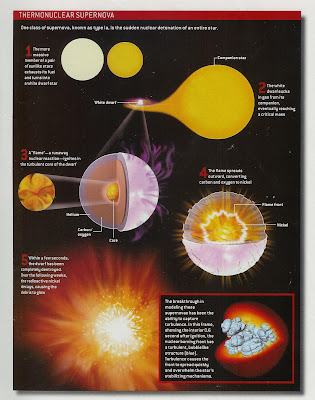
All authors have as an established pattern always the
Big Bang model assimilated in their theories. That model also comprises the
Inflation theorie, the theory supposing a very fast expansion of the universe (within 10^-35 sec). In principle every cosmologist accepts that model.
It is worthwhile to underline that the idea many people have about the Big Bang, namely an
explosion of dust in space from a specific point or something like that, is
absolutely wrong:
What was before the Big Bang is unknown, but it is clear that the notion of time in the Planck - period (10^-44 sec) does not have any meaning, it is leading to a singularity at t = 0, where all quantities get infinite values, which is a horror for scientists.
To explain the situation in that first period there is a search for a
theory coupling or integrating quantummechanics and relativity theory for which indeed
stringtheory is the most promising at the moment.
In the model of the Big Bang after the creation of the universe, space and the distribution of matter therein is stricly bound: because of the tremendous high energy with very high temperatures there is no difference between fundamental particles, they have no mass and are converted in each other without problems. Just after a “phase transition”, to compare with condensation of vapour by decreasing temperature, massive particles are created with mass clotting together by gravitation forces. The inflationary expansion of the system with stars and galaxies means an
expansion of space itself. The average density in space decreases and the distribution of matter forms no limitation to that space. In an “explosion” the fastest particles are moving to an empty space, in the Big Bang model particles fill space in an uniform way and expansion takes place from each point of that space. The expansion had little influence on the dimensions of galaxies and clusters, which were bound by gravitation, the space between the matter-objects has simply increased, to compare with plumcake: during baking the raisin dough will rise, there is no movement of the raisins with respect to the dough, yet distances between raisins increase because of the movement of the dough, the speed of the raisins with respect to each other is directly related to the quantity of dough between them.
Space expands “in the nothingness”, in the mean time material conglomerates are created, moving compulsary.
But as said before the Big Bang model involves also the "
INFLATION" process: on the expected expansion a superfast expansion is superimposed.
The inflation theory implies that scalarfields cause the expansion in a very early phase of space evolution after the start of the Big Bang, in such a way that it may be considered to be an “explosion” (but is is not!) in a fraction of a second, that is within 10^-34 sec., resulting in an increase in size of 10^30!
Within the
Planck-time: 10^-44 s, there was a situation that we still do not know or understand, A time t = 0 cannot physically exist because the infinite values physical quantities will get. An dark time so, of which the stringtheory states on the basis of mathematical considerations that you cannot even enter there, you simply will be sent back at the border, to say it that way, the sign of various quantities simply switches.
But let us assume a start with a very dense plasma at a very high temperature and a homogeneous radiation-dominated universe of unimaginable small size, which indicates that there is high, temperature-dependent potential-energy density, that large that it suggests a negative pressure, leading in a more or less natural way to a fast expansion.
During that expansion the potential energy decreases, transferring energy to the system.
Later on when matter is formed, temperature variations cause gravitational variations in matter density, from which in the long run objects are created nowadays observed by us on the firmament.
After the inflationperiod, that is after ~ 10^-35 s, there is the period of primordial nucleosynthesis, when from the original soup of elementary particles (quarks, gluons, electrons, etc.) protons and neutrons are formed, followed by the formation of the nucleï of light elements (He, Li, H), but then we are already a 100.000 year further in time, it is the time of “decoupling” or “recombination”. Radiation is yet hardly scattered and the photons get free way that is: maximum kinetic energy, the universe is “optically thin”. After this “last scattering” the
CMB-RADIATION starts, the cosmic microwave backgound radiation.
We should realize that albeit that the original universe was very strong curved (three-dimensionally, the time-coordinate is usually not involved, but is certainly also curved!), we just see today a very, very small part of its “horizon”, such a small piece is suggesting a very flat spacetime compared with the related part of the original universe. (imagine the inflation of a balloon!).
Labels: expansion


























